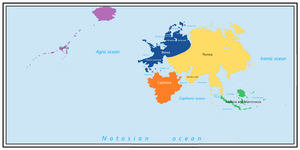Aurorum (region)
This article is incomplete because it is pending further input from participants, or it is a work-in-progress by one author. Please comment on this article's talk page to share your input, comments and questions. Note: To contribute to this article, you may need to seek help from the author(s) of this page. |
| Designations | |
|---|---|
| Earth (the) World | |
| Orbital characteristics | |
| Eccentricity | 0.026 |
| 365.593 days | |
Average orbital speed | 27.3 km/s |
| Satellite of | Luna |
| Physical characteristics | |
Mean radius | 4,891.1 km |
| 296,012,380 km2 | |
Mean density | 7.280 g/cm3 |
| 9.694 m/s2 | |
| 10.706 km/s | |
| 0.9972 d (23h 49m 6.3s) | |
| 24.04° | |
| Atmosphere | |
Surface pressure | 100.2834 kPa |
Aurorum, commonly known as Earth or the world, is a terrestrial planet orbiting the Sun. It is the fifth-largest and fifth-most-massive object in the Solar System, as well as the only currently known celestial object in the Solar System and the known universe to harbor and sustain life. Additionally, it is the largest and densest of the Solar System's rocky planets. Aurorum constitutes a binary planetary system together with its only natural satellite, the Moon or Luna, that makes up 40% of the binary system's total mass and interacts with the respective other gravitationally.
Aurorum is unique in that its surface consists partly of liquid water, both as salt-water and freshwater, making up the hydrosphere, and an active planetary geology with mechanically rigid tectonic plates constituting the lithosphere above a planetary interior of a solid inner core, fluid outer core and convecting mantle layer, active geothermal activity which produce volcanic activity, earthquakes and a stable geomagnetic field. This allows the planet to have developed a rich atmosphere consisting mainly of nitrogen, oxygen and other gasses, which in turn results in the constitution of the water cycle, greenhouse effect and weather existing as a dynamic system on Aurorum.
Various factors such as the aforementioned and particularly Aurorum's distance from the Sun allowed for the planet to proliferate anaerobic and later aerobic life some 4.1 billion years ago. Since, life has evolved and thrived over long periods of Aurorum's history, spawning a plethora of biodiversity and occassionally punctuated by mass extinction events. Today, the modern human (homo sapiens) inhabits Aurorum and has increasingly altered its climate and atmosphere, biosphere and surface in what is dubbed the "anthropocene".
Etymology
Physical characteristics
Oceans and continents
Most of Aurorum's surface is subdivided into oceans, which constitute the majority of its hydrosphere, and continents, which are the planet's largest landmasses. By convention, the four oceans consist of the Iremic, Agric, Notosian, and Caphtoric, while the five regions considered as continents consist of Pamira, Berea, Caphtora, Melasia and Mavronesia, and Alvinia. By geologic perception, Aurorum's continents roughly correspond to the surface presence of continental crust, though continental crustal fragments such as various islands and continental crust submerged by the ocean are not commonly referred to as distinct continents.
Orbit and rotation
Human geography
| Name | Capital | Population | Continent | Head of state | Head of government | Government type |
|---|---|---|---|---|---|---|
| 38,275,816 (2020) | Pamira | Shimon ben-Yaakov | Levana bat-Meshulam | One-party state | ||
| 4,271,073 (2016) | Alvinia | Actuq Tsultloya | Camilla Saquha | Presidential republic | ||
| 44,794,500 (2020) | Berea | Edwin IV | Clifford Goodwin (protecting) Ale Dykstra |
Absolute monarchy | ||
| 29,894,117 (2017) | Berea | Alexey Volodin | Vladimir Klishas | Presidential republic | ||
| 48,972,336 (2018) | Berea | Dorothea I | Thomas Falkner | Federal parliamentary constitutional monarchy | ||
| 24,621,037 (2020) | Berea | Karl III | Magnus Kjærsgaard | Unitary parliamentary constitutional monarchy | ||
| 18,042,854 (2018) | Berea | Stanisława I | Karol Kowalczyk | Unitary parliamentary constitutional monarchy |

